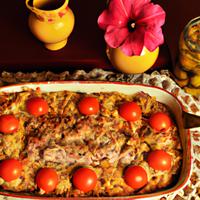
1 serving (250 grams) contains 350 calories, 20.0 grams of protein, 15.0 grams of fat, and 30.0 grams of carbohydrates.

Log this food in SnapCalorie

Nutrition Information
Calories |
330.2 | ||
|---|---|---|---|
% Daily Value* |
|||
| Total Fat | 14.2 g | 18% | |
| Saturated Fat | 4.7 g | 23% | |
| Polyunsaturated Fat | 0 g | ||
| Cholesterol | 37.7 mg | 12% | |
| Sodium | 754.7 mg | 32% | |
| Total Carbohydrates | 28.3 g | 10% | |
| Dietary Fiber | 1.9 g | 6% | |
| Sugars | 2.8 g | ||
| protein | 18.9 g | 37% | |
| Vitamin D | 47.2 mcg | 236% | |
| Calcium | 141.5 mg | 10% | |
| Iron | 1.9 mg | 10% | |
| Potassium | 283.0 mg | 6% | |
* Percent Daily Values are based on a 2,000 calorie diet. Your daily values may be higher or lower depending on your calorie needs.
Food Attributes
Source of Calories
About Tuna fish casserole
Tuna Fish Casserole is a comfort food classic originating from mid-20th century American cuisine, designed as an economical and hearty meal. It typically combines flaky canned tuna, egg noodles, or pasta with a creamy sauce, often made from condensed cream of mushroom soup, and is topped with breadcrumbs or melted cheese for a golden, crisp finish. Variations may include peas, celery, or onions for added texture and nutrients. Rich in protein from the tuna and often fortified with omega-3 fatty acids, it provides essential nutrients like vitamin D and selenium. However, its healthiness varies depending on preparation—store-bought soups and cheeses can contribute high sodium and saturated fat levels. Health-conscious versions may substitute lighter sauces, whole-grain pasta, or fresh vegetables to enhance fiber and reduce calorie content while preserving its comforting appeal. Tuna Fish Casserole remains a nostalgic, versatile dish for casual family dinners.



